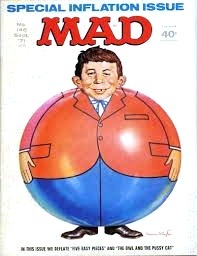Buying a Mad Magazine
by
, 02-27-2018 at 08:27 AM (340 Views)
Morning of February 27, 2018. Tuesday.
I am in an unfamiliar store and looking at a large wooden display unit for magazines. It has four shelf sections and is as long as the aisle.
I notice an American Mad Magazine on the third shelf up, the front cover of which resembles that of issue 145 from September 1971 (with the original’s cover price being 40 cents), though the art is somewhat sketchy, seemingly by Don Martin, and drawn smaller and lower than the real version. It also seems to be implied to be a hot air balloon with a male character hanging from the basket’s gunwale on the left side and a female character facing left in profile and looking down at him with a question mark over her head.
I pick it up with my left hand but I never open it. Still, I perceive that some of the pages are stiffer than usual, perhaps due to several different thin cardboard pages throughout. I consider that it may be a special issue. I assume it is two dollars and prepare to buy it, discovering that I have an Australian two-dollar coin in my right hand.
Zsuzsanna is also soon present and she finds a magazine that she plans to buy. It seems to be a different issue of Mad Magazine, but I do not see the cover.
I go to the singular checkout counter, which looks somewhat like the type in a convenience store, although there is no display unit at the front. I prepare to pay for the magazine when I notice that I am also carrying, in my left hand (and below the magazine), what looks like three VHS cases, though smaller than real ones and ambiguously associated with DVD cases. Looking at them, they all seem to be folk music albums.
Their covers are all in brown and beige hues and feature mostly print (apparently lists of song titles). I put them in a display bin in which others are strewn, at the end of the aisle near the checkout. Going back, I notice that I still have one case in my hand, and wonder how I had missed putting it back. I feel somewhat annoyed by my absentmindedness.
When I am at the checkout (Zsuzsanna standing on my left), the unfamiliar male cashier tells me it will be twelve dollars. Looking at the cover, even seeing that the price in the upper right corner reads as $3.12 (three dollars and twelve cents), I still exclaim, “How can a two dollar magazine be twelve dollars?” I consider that I might pay the amount, as I start to remember that American magazines in Australia are much more expensive than their printed cover price, but I wake at this point.
Zsuzsanna is usually on my left in the last segment of a dream. This is subliminal awareness that she is on my left as we are sleeping, and as such, is a common DSI (Dream State Indicator).
The Mad Magazine cover depicts static “failed flight waking symbolism”, suggesting that the character is about to fall, potentially precursory symbolism of my dream self in waking transition (the typical biological jolt of waking). However, these common dynamics had been quashed in this case, both in being featured on a liminal space divider (magazine cover) and oriented incorrectly. This is otherwise based on the biological vestibular system ambiguity of being unconscious, unrelated to waking life. There has been at least one VSA factor in at least one of my dreams of each sleeping period for over fifty years, so pretending that VSA autosymbolism is relevant to waking life is asinine (other than when literally prescient, though I doubt I will be in a hot air balloon or buying a Mad Magazine in the future).
This dream is the typical checkout scenario, which is autosymbolism of consciousness reascension (leaving the dream state), one of my most common factors of waking autosymbolism since childhood. The confusion about prices (as well as having to do the same thing more than once) is a common dream state dynamic (as the non-lucid dream self does not usually possess or maintain viable thinking skills or temporality) of which is unrelated to waking life and the conscious self.
The preconscious personification (the cashier) is an unfamliar male to prevent my dream from having waking life associations. (However, in direct contrast, this factor is sometimes inexplicably prescient.)
RAS mediation renders the store as unfamiliar to prevent my conscious mind from mistaking it as being related to waking life (for prevention of false or ambiguous memories). (There is always the possibility that it may be visually prescient, but it is probably only the usual unique fictitious composite.)
In summary, this dream features the usual components and autosymbolism. The Mad Magazine cover is similar to the first issue that my mother bought me when I began to collect them in 1971, thus this represents the induction marker of my dream, while the checkout is the exit marker.















